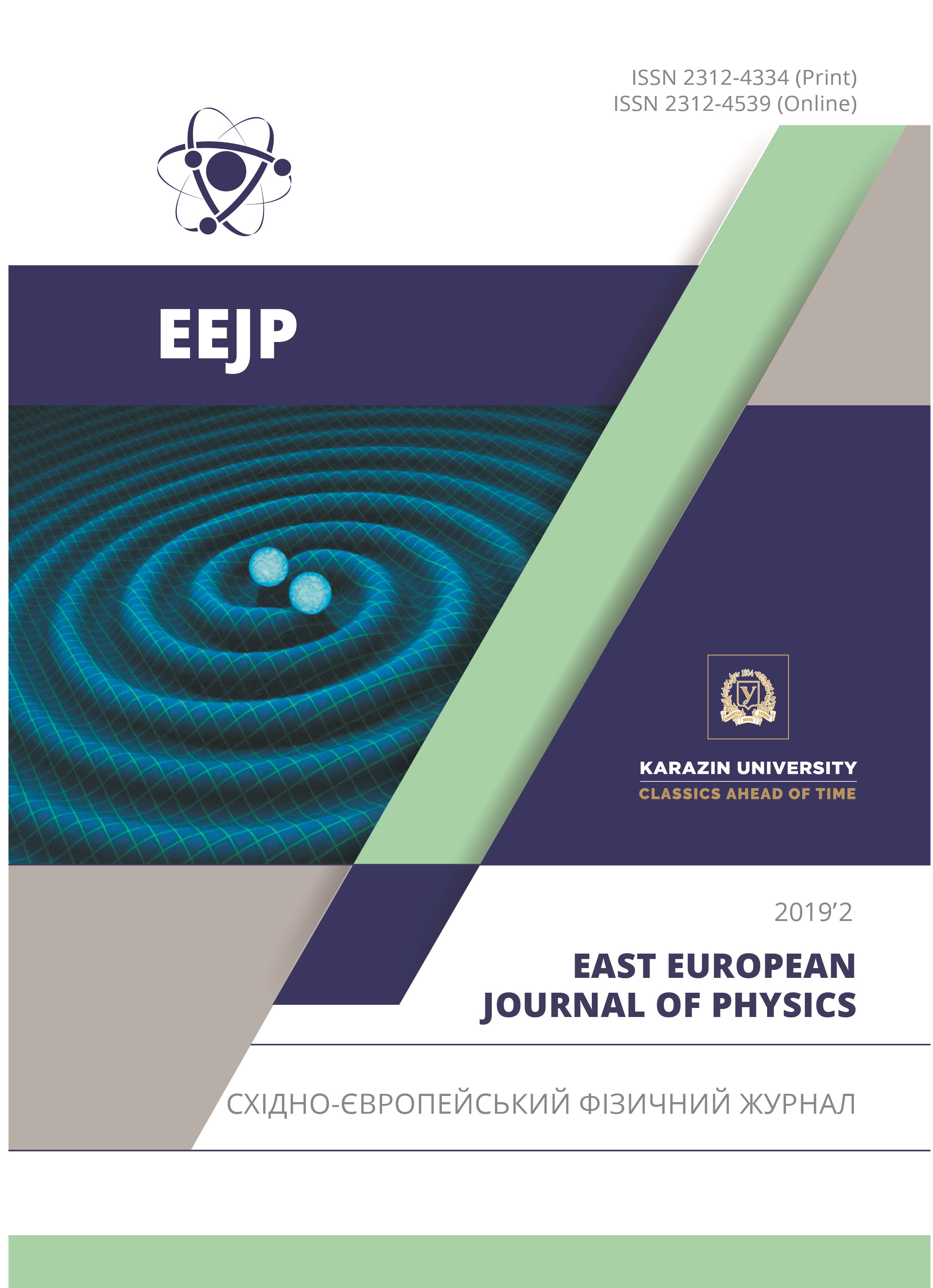GEANT4 Modeling Of Energy Spectrum Of Fast Neutrons Source For The Development Of Research Technique Of Heavy Scintillators
Abstract
The proposed work demonstrates the results of creating and investigating the mathematical model of the source of fast neutrons. Computer modeling of the energy spectrum of fast neutrons was carried out for 239PuBe neutron source. The model of the source of fast neutrons has been developed. Neutrons in this model have an energy spectrum from 100 keV to 11 MeV with 100 keV step. Simulation is performed by the Monte-Carlo method. The model carrier is a computer program developed in the C++ programming language in the Linux operating system environment, using the Geant4 toolkit. All necessary classes describing low-energy models were used for the simulation of the passage of neutrons through materials of detectors. Those take into account the elastic scattering, inelastic scattering, radiative capture and fission. We consider these processes because models of processes implemented in our software will be also used for other problems of neutrons transport, for example, for passing neutrons through various substances, and for conducting virtual laboratory works. The PhysicsList class of our program contains classes G4NeutronHPElastic, G4NeutronHPElasticData, G4NeutronHPInelastic, G4NeutronHPInelasticData, G4NeutronHPCapture, G4NeutronHPCaptureData, etc. based on the NeutronHP model for neutron interactions at low energy, as well as the neutron data library G4NDL4.5. Diagrams containing energy spectra of a source of fast neutrons modeled in two ways are presented in the paper. The analysis of the obtained energy spectra is carried out. Virtual nuclear physics experiments are carried out with the aim of testing the elaborated neutron-matter interaction model. The processes occurring in scintillator substances during the passage of fast neutrons through them, have been studied. 109 neutrons were used as primary particles emitted isotropically, and we used our simulation results of 239PuBe neutron source to describe the initial energy spectrum. The created model of 239PuBe neutron source can be used for the investigation of scintillation detectors Bi4Ge3O12, CdWO4, Gd2SiO5 and others, as well as studying their characteristics. Processes in heavy oxide scintillators substance during the registration of fast neutrons can be studied using the developed model. It is shown that for registration of the flow of neutrons from 239PuBe neutron source, using Bi4Ge3O12 or CdWO4 scintillators is more preferable. Results of the virtual nuclear physical experiments satisfy the published experimental data.
Downloads
References
V.D. Ryzhikov, B.V. Grinyov, G.M. Onyshchenko, L.A. Piven, S.V. Naydenov and O.K. Lysetska, Functional Materials, 3(21), 345-351 2014, https://doi.org/10.15407/fm21.03.345.
Neutron interaction with matter, in http://nuclphys.sinp.msu.ru/partmat/pm04.htm.
M.E. Anderson and R.A. Neff, Nuclear Instruments and Methods, 99(2), 231-235 1972, https://doi.org/10.1016/0029-554X(72)90781-1.
G.I. Britvich, V.G. Vasil'chenko, Yu.V. Gilitsky, A.P. Chubenko, A.E. Kushnirenko, E.A. Mamidzhanyan, V.P. Pavlyuchenko,V.A. Pikalov, V.A. Romakhin, A.P. Soldatov, O.V. Sumaneev, S.K. Chernichenko, I.V. Shein and A.L. Shepetov, Instruments and Experimental Techniques, 47, (5), 571-584 2004, https://doi.org/10.1023/B:INET.0000.
J. Allison, K. Amako, J. Apostolakis, P. Arce, M. Asai, T. Aso, E. Bagli, A. Bagulya, S. Banerjee, G. Barrand, B.R. Beck, A.G. ogdanov, D. Brandt, J.M.C. Brown, H. Burkhardt, Ph. Canal, D. Cano-Ott, S. Chauvie, K. Cho, G.A.P. Cirrone, G. Cooperman, M.A. Cortés-Giraldo, G. Cosmo, G. Cuttone, G. Depaola, L. Desorgher, X. Dong, A. Dotti, V.D. Elvira, G. Folger, Z. Francis, A. Galoyan, L. Garnier, M. Gayer, K.L. Genser, V.M. Grichine, S. Guatelli, P. Guèye, P. Gumplinger, A.S. Howard, I. Hřivnáčová, S. Hwang, S. Incerti, A. Ivanchenko, V.N. Ivanchenko, F.W. Jones, S.Y. Jun, P. Kaitaniemi, N. Karakatsanis, M. Karamitros, M. Kelsey, A. Kimura, T. Koi, H. Kurashige, A. Lechner, S.B. Lee, F. Longo, M. Maire, D. Mancusi, A. Mantero, E. Mendoza, B. Morgan, K. Murakami, T. Nikitina, L. Pandola, P. Paprocki, J. Perl, I. Petrović, M.G. Pia, W. Pokorski, J.M. Quesada, M. Raine, M.A. Reis, A. Ribon, A. Ristić Fira, F. Romano, G. Russo, G. Santin, T. Sasaki, D. Sawkey, J.I. Shin, I.I. Strakovsky, A. Taborda, S. Tanaka, B. Tomé, T. Toshito, H.N. Tran, P.R. Truscott, L. Urban, V. Uzhinsky, J.M. Verbeke, M. Verderi, B.L. Wendt, H. Wenzel, D.H. Wright, D.M. Wright, T. Yamashita, J. Yarba and H. Yoshida, Nuclear Instruments and Methods in Physics Research, 835, 186-225 2016, https://doi.org/10.1016/j.nima.2016.06.125.
W. Press, S. Teukolsky, W. Vetterlong and B. Flannery, editors, Numerical Recipes: The Art of Scientific Computing (Cambridge University Press, 2007), http://www.cambridge.org.
Geant4 User’s Guide for Application Developers (CERN, 2018), in: http://cern.ch/geant4-userdoc/UsersGuides/ForApplicationDeveloper/fo/BookForApplicationDevelopers.pdf
Geant4 Physics Reference Manual (CERN, 2018), in: http://cern.ch/geant4-userdoc/UsersGuides/PhysicsReferenceManual/fo/PhysicsReferenceManual.pdf
Наука про матеріали: досягнення та перспективи. Том 1, [Material Science: Achievements and Prospects. Volume 1], (Akademperiodyka, Kyiv, 2018), pp. 652.
Authors who publish with this journal agree to the following terms:
- Authors retain copyright and grant the journal right of first publication with the work simultaneously licensed under a Creative Commons Attribution License that allows others to share the work with an acknowledgment of the work's authorship and initial publication in this journal.
- Authors are able to enter into separate, additional contractual arrangements for the non-exclusive distribution of the journal's published version of the work (e.g., post it to an institutional repository or publish it in a book), with an acknowledgment of its initial publication in this journal.
- Authors are permitted and encouraged to post their work online (e.g., in institutional repositories or on their website) prior to and during the submission process, as it can lead to productive exchanges, as well as earlier and greater citation of published work (See The Effect of Open Access).








